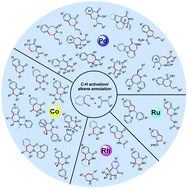Recent advances in transition metal-catalyzed heteroannulative difunctionalization of alkenes via C–H activation for the synthesis of heterocycles
Abstract
Heterocyclic compounds are the fundamental structural motifs distributed in natural products, pharmaceuticals and biologically active compounds. Thus, there is increasing interest in the development of novel synthetic strategies for the construction of these privileged motifs. Recently, alkenes have emerged as sustainable, abundant, versatile two-carbon synthons and display great potential in the synthesis of heterocycles. Along these lines, transition metal-catalyzed heteroannulative difunctionalization of alkenes via C–H activation has been developed as a practical and powerful synthesis route towards heterocyclic frameworks with high atom- and step-economy. In this review, we highlight the recent advancements in the field of transition metal-catalyzed C–H annulation of alkenes for the preparation of heterocycles such as indolines, isocoumarins, benzoxepines, benzoazepines, tetrahydroisoquinolines, lactams, dihydropyridinones, isoquinolinones, and dihydrophosphaisocoumarins, based on different metal catalysts including palladium, rhodium, ruthenium, and cobalt. Moreover, the related reaction mechanisms and significant applications are also discussed.

- This article is part of the themed collection: 2022 Organic Chemistry Frontiers Review-type Articles


 Please wait while we load your content...
Please wait while we load your content...